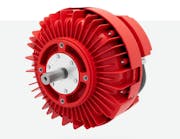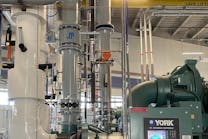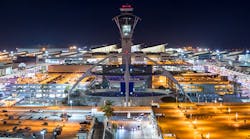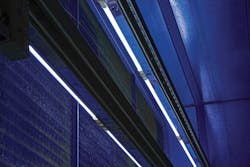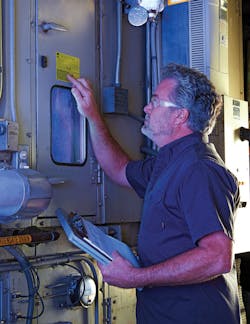Case Study by UV Resources
With nine terminals totaling several million square feet of floor space, Los Angeles International Airport (LAX) is massive. It’s also crowded: the 85 million passengers who passed through it in 2017 made it the world’s fifth busiest airport.
Keeping those travelers comfortable and safe falls to the airport’s facility management teams, who routinely look to boost efficiencies and decrease maintenance calls across their immense service area. So it’s no surprise that while solving a minor air conditioning issue, one facility manager identified a way to improve indoor air quality (IAQ) for the entire airport.
“A tenant in Terminal 2 complained of a musty smell in their offices,” recalls Richard Yakel, the airport’s air conditioning supervisor. “We quickly determined that the odor resulted from the buildup of mold and bacteria on the air handler evaporator coil; a very common condition, especially given our humid, seaside environment.”
Although Yakel’s maintenance crews could remove the mold with solvents and elbow grease, he knew that mechanical cleanings and antimicrobial agents were only a temporary solution. He recognized that – like all equipment – without a continuous maintenance program, the conditions would quickly reappear.
Moreover, the organic buildup on the coil had caused a pressure drop that reduced the volume of air passing through the coil, as well as its heat-transfer efficiency. In other words, biofilms that can be several millimeters thick can ‘choke’ an air handler, severely inhibiting system performance.
And, he reasoned that if there was trouble in one of the airport’s air handling units (AHU), similar conditions might be found in some of the facility’s other 200+ AHUs.
In Search of Better Indoor Environmental Quality
Seeking a more permanent solution, Yakel turned to Jim Edson with Santa Clarita-based NUView Environmental in 2009, to learn if ultraviolet germicidal irradiation (UVGI) would be a cost-efficient and lasting means to remove such biological growth in HVAC cooling coils, plenum interiors, drain pans and air filters.
According to Edson — a distributor for UV Resources, the company whose founders pioneered the use of UV-C in HVAC equipment in the early 1990s — the UV-C energy degrades the organic matter. Ionization drives UV-C’s power to alter chemical bonds, causing lasting damage to DNA, ultimately killing the cell. Over time, the 254-nm germicidal wavelength also reflects deep into the coils to eliminate the build-up that mechanical and chemical washing often misses. Once gone, biological growth won’t re-form as long as the lamps are maintained.
This would solve Yakel’s air quality issue. However, Edson explained that this benefit is just the tip of the UV-C iceberg.
Besides improving air quality, the hidden value of UV-C is its ability to improve airflow, boost heat exchange efficiency and reduce maintenance needs.1 It accomplishes this veritable HVAC hat trick for an average equipment cost of less than $0.15 per cfm. In fact, the cost of the efficiency-enhancing UV-C equipment is a mere fraction of the 10-35 percent potential reduction in energy and maintenance costs it offers. In a facility the size of LAX, that’s a potentially huge annual savings.
Needless to say, Yakel was intrigued with UV-C technology.
A Successful Test
Although UV-C is a proven technology, with tens of thousands of systems sold each year, he wanted to verify its performance before committing to using it airport-wide.
He decided to conduct a test installation on the odorous AHU. Yakel’s team first measured the unit’s static pressure and airflow levels using a Magnehelic differential pressure gauge.
Following this baseline measurement, the team installed high-output DEF (Double-Ended Fixture) UV-C fixtures from UV Resources in the 14,000 CFM AHU. The high-output DEF series generates up to twice the ultraviolet irradiation levels compared to standard fixtures, to kill and/or degrade the toughest microorganisms and organic matter, whether surface or airborne.
Pressure readings were taken monthly for the following six months.
“My team and I were surprised by how quickly the germicidal wavelength cleaned the HVAC evaporator coil, fan motor housing and blades. However, we were truly stunned to witness a 15 percent (2,000 cfm) increase in airflow levels after just a week of operation.”
“Almost immediately after installing the UV-C fixtures, the troubled air handler was able to meet thermostat set points and there was no odor,” he says.
The experiment’s timing proved fortuitous. The airport was in the initial stages of planning a multi-year, $4.11 billion improvement and redevelopment project that would include renovation of existing facilities, as well as a major expansion of the Tom Bradley International Terminal. UV-C Lighting has been included in the HVAC design standards for LAX.
With budget funds available for HVAC improvements, Yakel made a case for equipping all of the airport’s 200+ air handlers with UV-C as a way to enhance indoor environmental quality for passengers and employees.
Breathing Easier
One of the reasons that Yakel opted for UV Resources’ High-Output DEF series was its robust design. With a 120-277 volt waterproof ballast, stainless steel construction and built-in weep holes, the DEF can withstand the harshest commercial or industrial HVAC environments. Power supplies and lamps are electronically matched to provide the highest output while maintaining the longest life expectancy. Yakel also liked the fact that the DEF comes with a three-year warranty, compared to one year for competing products.
“Our application requires the most durable equipment. Anything we specify has to run 24/7 and it has to last for at least 20 years,” notes Yakel. “It has to be compatible with new and existing air handlers and other system components, as well as the building management and remote monitoring systems. Parts must also be readily available.”
Each of the airport’s terminals has multiple air handlers, ranging from five in Terminal 1 to 30 in Terminal 4. AHUs range in cooling capacity from 10 to 40 tons; some of which have been in place for decades.
According to Edson, none of this was a problem: the beauty of UV-C is that it will work with any type of air handling equipment regardless of brand, capacity or age – the science remains the same. The required number of UV-C fixtures varies by unit size, but UV Resources’ software program specifies the exact amount of UV-C energy needed based on the height and width of the coil and plenum. Some of LAX’s really big air handlers needed 24 UV-C fixtures to do the job.
At the end of the first three-year contract period, more than 75 air handlers had been retrofitted with UV-C. The UV-C contract went out to bid again in June 2014 and NUView was the lowest bidder, securing the contract for the second three-year term.
The plug-and-play wiring meant that Yakel’s crew could retrofit the DEF fixtures in-house, while new AHUs would be required to have UV-C already installed. Workers prefabricate rows of fixture assemblies in the shop, minimizing downtime for the air handlers. They can then install the prefabbed fixture rows and bulbs for a medium sized air handler in a single work shift (typically from 12 midnight to about 5:00 a.m. when the disruption is minimal).
The UV-C fixtures have reduced maintenance costs and freed crews up for other tasks. With union positions earning an average $28 per hour, the typical eight-hour physical air handler cleanings were each costing roughly $230 and needed to be performed on a quarterly basis. At nearly $900/year/AHU multiplied across 200 AHUs - the new technology could eventually save upwards of $180,000 annually in maintenance costs alone.
Following the addition of the UV-C fixtures, the airport’s maintenance crews still visually inspect the air handlers and coils, but generally don’t have to clean the cooling coils as often.
“I have personally inspected the drain pans and plenums of several units and have seen no mold growth,” concludes Yakel. “The lack of organic growth on the coils has also improved the heat-transfer efficiency and airflow levels, thereby reducing electrical consumption.”
But Yakel sees cost and time savings as fringe benefits. His main goal was to improve indoor air quality for the millions of people who use the airport each year, and that has certainly been the case. “We haven’t had any more complaints,” he beams.
In more ways than one, everyone at LAX can now breathe more easily.
1 ASHRAE. (2015). ASHRAE handbook – HVAC applications (ch. 60.8). Atlanta: ASHRAE. https://www.ashrae.org/resources--publications/handbook/description-of-the-2015-ashrae-handbook-hvac-applications
